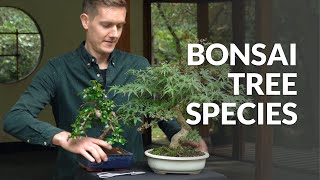Hibiscus Bonsai Care guidelines
Hibiscus trees like to be placed in full sun or semi-shade. Tropical species must be protected from frost and should be taken inside the house over the winter. Grow lights are helpful for indoor overwintering. Hibiscus syriacus is hardy, but should be protected from strong frost when it is planted in a small bonsai container. A cold but frost-free greenhouse is an ideal winter place for Hibiscus syriacus.
The hibiscus must be thoroughly watered as soon as the soil gets dry. The roots must not dry out too much because otherwise the flower buds will be dropped. Don't overwater on the other hand. The hibiscus prefers neutral water with a pH value between 6.5 and 7.5. Continue reading about watering Bonsai trees.
Watering
Free lecture from the Beginners CourseFertilize the tree once a month with solid organic fertilizer or use a liquid fertilizer every week.
The branches and shoots of the hibiscus bonsai tree can be pruned considerably and frequently in the early stages of bonsai development to create a good ramification. On mature trees shorten the new shoots leaving one or two leaves. If you want the tree to bloom, stop trimming in June. Hibiscus can be wired but bending must be done with great caution because the branches break easily. Guy wires are also a good way to shape the branches. Continue reading about pruning Bonsai trees.
Repot hibiscus trees every two to three years in summer, older specimen less often, using a standard soil mixture. For old trees use a higher ratio of Akadama in your mix. The hibiscus takes normal root pruning well. Continue reading about repotting Bonsai trees.
Hibiscus can be propagated from seed in spring or from cuttings in summer. Air-layering is also an option.
Hibiscus trees are hardly attacked by pests and diseases. Frequent watering with calcareous water or a lack of fertilizer can cause chlorosis. Use a ferric fertilizer in this case. For more detailed information on these techniques, check out our Bonsai tree care section.

Hibiscus Bonsai, photo by LiveBonsaiTree
General information about the Hibiscus Bonsai tree
The leaves of the hibiscus are dark green and toothed or lobed. Tropical hibiscus species have glossy leaves while the temperate species have a matte leaf surface. The bark is light beige and becomes grey and rough with age. The showy flowers, which can appear all year round and last only one day each in most cases, are the most striking feature of the hibiscus. They are trumpet-shaped with five or more petals and stamens in a long central tube. There are species and cultivars with red, white, yellow, orange, pink, purple or blue flowers which can be simple or double. The tropical Hibiscus rosa-sinensis is best known and sometimes used for medium sized or larger bonsai, while Hibiscus syriacus, which is a frost-hardy temperate species, has a more delicate growth and is also appropriate for smaller bonsai trees. If you need help identifying your tree, take a look at our Bonsai tree identification guide.





